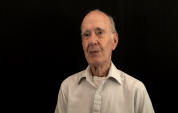6:09 | Eugene Whitfield said goodbye to the USS Ticonderoga after it returned to Seattle, too damaged to continue. Put in charge of ordnance at the Naval Air Station in Jacksonville, Florida, he didn't have to dodge any more kamikaze attacks and he even had time to develop a special skill and teach it to new pilots.
Keywords : Eugene Whitfield Seattle WA shipyard Naval Air Station Jacksonville FL magazine skeet pilot target tournament North Pole Kodiak AK patrol iceberg Aleutians

After basic training, where he learned the art of fire fighting aboard ship, Eugene Whitfield went to a Naval air group in Quonset Point, Rhode Island. New aircraft for carriers were received and prepped for battle, and this task began a long career for him in aviation munitions.
He decided to stay in Naval Aviation and soon, Eugene Whitfield found himself on the brand new aircraft carrier, the USS Ticonderoga. After a shakedown cruise in the Atlantic, the ship passed through the Panama Canal and on to Pearl Harbor, which was still reeling from the surprise Japanese attack.
The routine for an Aviation Ordnanceman meant rising long before dawn to prepare the planes for battle. Daylight meant they were on their way. Eugene Whitfield recalls how they worked with lamps strapped to their arms.
Eugene Whitfield tells the story of the twin kamikaze attacks on the aircraft carrier Ticonderoga. The first plane caught them by surprise when the Japanese pilot came straight down out of the sun. The second one hit the bridge and the captain was wounded, but he proved to be very tough.
Aviation Ordanceman Eugene Whitfield recalls the stoic actions of Captain Dixie Kiefer during the kamikaze strike on the Ticonderoga. As if the crippling attack wasn't enough trouble for the crew, a typhoon lurked nearby.
After the war ended in the Pacific, Eugene Whitfield decide to make a career of it and served aboard many different carriers. A visit to Hiroshima was a sobering experience, and a search for a missionary led to an amazing coincidence.